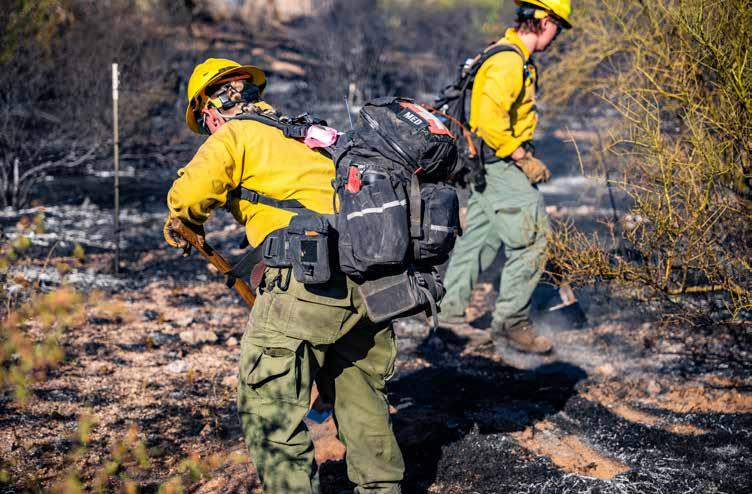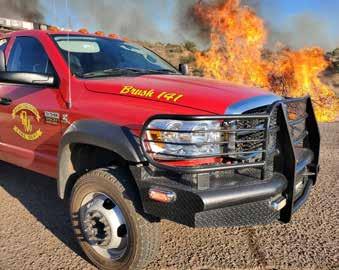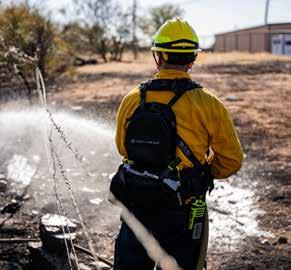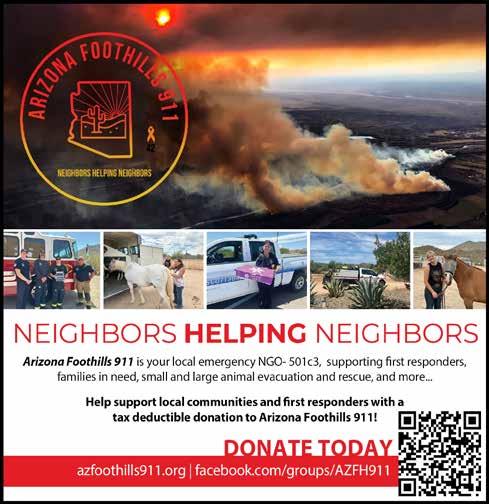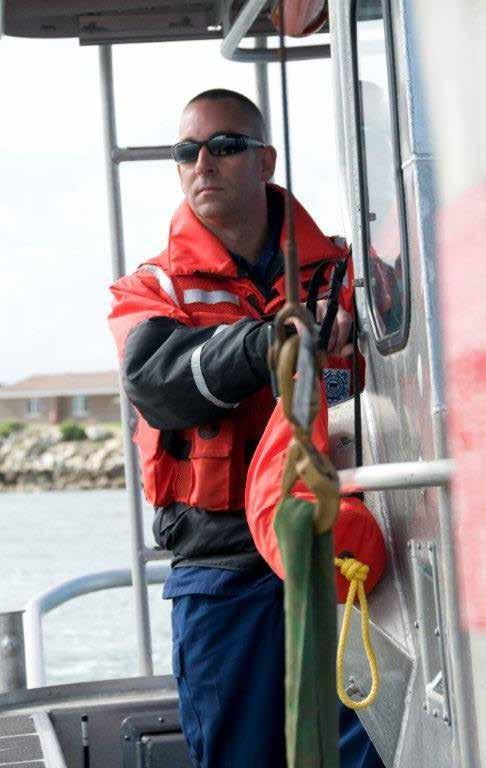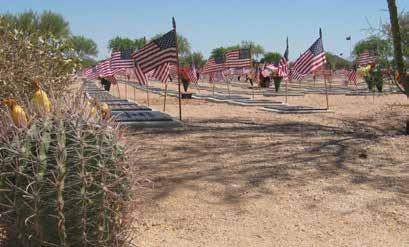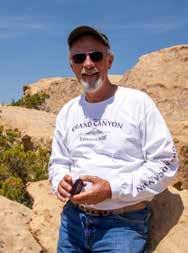From the Publisher
Publisher Shelly Spence
Managing Editor
Joseph J. Airdo
Graphic Designer
Meaghan Mitchell
Contributing Writers
Joseph J. Airdo
Francine Coles
Shannon Severson
Photographers
Francine Coles
Loralei Lazurek
Advertising Sales
Cindi Calcinari
860-966-3271 cindi@imagesaz.com
Images Arizona P.O. Box 1416
Carefree, AZ. 85377
623-341-8221
shelly@imagesaz.com imagesarizona.com
AAs the desert temperatures begin their annual climb toward summer, there’s a palpable energy in the air. May in Arizona marks that precious transition — when we savor the last few weeks of open windows and outdoor dinners before the summer heat settles in for its extended stay. It’s a time of preparation and appreciation, much like the themes woven throughout this month’s issue of Images Arizona.
Our opening feature, “Shield & Shelter,” couldn’t be more timely as we approach wildfire season. Shawn Gilleland’s expert guidance on creating defensible space and developing evacuation plans provides essential preparation for those of us in wildland-urban interface areas — allowing peace of mind as the landscape dries.
This month's cover story, "String Theory," showcases Bill Dutcher, whose masterful "Extreme Acoustic" concert series at the Musical Instrument Museum has become a cornerstone of Arizona's guitar scene. Dutcher's ability to transform a single instrument into what sounds like an entire ensemble exemplifies the extraordinary talent in our community.
For those who appreciate nature’s more delicate artistry, our photo essay “Wings of Wonder” showcases Bruce D. Taubert’s extraordinary macro photography of butterfly and moth wings. His images reveal intricate patterns invisible to the naked eye — a reminder that sometimes the most breathtaking beauty exists in the smallest details.
As you explore these pages, I hope you’ll be inspired to look at our desert home with fresh eyes — seeing both the challenges and wonders that make Arizona such a remarkable place to live.
Cheers!
Shelly Spence Publisher, Images Arizona
Photography by Loralei Lazurek
Kenneth Peloke, The Last Roundup, Oil on Canvas, 54” by 54”
Kenneth Peloke, Rolling Stone, Oil on Canvas, 48” by 60”
AAs Arizona’s summer approaches, so does the looming threat of wildfire season for residents in the wildland-urban interface (WUI) areas. For homeowners in Rio Verde Foothills, Desert Hills, Carefree, Cave Creek and North Scottsdale, preparation isn’t just recommended — it’s essential. The time to act is now, before the first smoke appears on the horizon.
This year’s fire season could be particularly challenging. This spring, the Arizona Department of Forestry and Fire Management warned that lingering warm and dry conditions, coupled with drought-stricken fuel, could drive widespread fire activity. More than half the state is in extreme drought status.
“This year’s season is not based on elevation or fuel type,” explains DFFM State Fire Management Officer John Truett. “A lackluster winter and spring, in terms of rain and snow, have really put us at a disadvantage statewide.”
Areas south of the Mogollon Rim, including the Sonoran Desert and southern Arizona, face potentially larger-intensity fires due to fuel types and loading. Moisture in late March and early April may have provided a brief reprieve, but officials remain concerned about the season ahead. Last year, Arizona firefighters responded to 2,162 wildfires — a 33% increase from 2023 — burning 282,507 acres across private, state and federal lands.
Writer Joseph J. Airdo
Photo Courtesy of Rural Metro Fire
The absolute mustdos include creating defensible space or, at minimum, thoroughly cleaning up your property. Families should discuss evacuation plans together and have a clear idea of what actions they would take during an emergency.
Shawn Gilleland
Recent advancements in firefighting techniques include more rapid deployment of air operations during wildfires, along with drone mapping and artificial intelligence-based prediction tools that help anticipate fire behavior. But the best defense begins with homeowners themselves.
These preparations aren’t just about protecting material investments. They’re about preserving peace of mind, family safety and community resilience during a season that grows more unpredictable each year.
This month, with Shawn Gilleland, public information officer for Rural Metro Fire and Arizona Foothills 911, as our expert guide, Images Arizona explores how to transform your property from vulnerable to vigilant.
CREATE YOUR DEFENSIVE PERIMETER
“The single most important wildfire preparation is the creation of defensible space around your home,” Gilleland says. “This is particularly critical for properties located in the WUI — areas where concentrations of homes are built directly into wildland areas.”
Understanding the science behind wildfire behavior reveals why defensible space works so effectively. Fire requires three elements to thrive: fuel, heat and oxygen — often called the fire triangle.
“By removing the fuel, the fire runs out of material to consume and eventually stops or dies out,” Gilleland explains. “Clearing flammable grasses, dead brush, and ‘understory’ — all the dead material that falls from trees and bushes, such as mesquite needles and leaves — prevents fire from traveling to your home.”
The concentric ring approach to defensible space allows homeowners to prioritize their efforts, starting with the most critical areas. Gilleland recommends beginning with the first 5 feet immediately surrounding your home, creating what fire experts call the “home ignition zone.” In this area, remove all flammable materials, including mulch, dead plants, dried leaves and firewood.
“These actions improve your home’s ignition resistance, reducing the chances of windblown embers finding a place to land in flammable material, smoldering and igniting a spot fire,” Gilleland says.
From there, work outward in expanding rings — 10 feet, 20 feet, 30 feet, and ideally 100 feet if your property allows. In these zones, the goal isn’t to create a barren landscape but rather to space plants appropriately, remove ladder fuels (vegetation that allows fire to climb from the ground to treetops) and maintain trees by removing lower branches.
For luxury homeowners concerned about maintaining aesthetic appeal, defensible space doesn’t require sacrificing landscape design. Strategic placement of hardscape features like decorative stone walls, patios and water features can serve as both firebreaks and design elements. Fire-resistant plants like ice plants, aloe, lavender and many native succulents can provide color and texture while minimizing risk.
“Defensible space doesn’t mean creating a moonscape or eliminating all vegetation,” Gilleland stresses. “The idea is to space out bushes, trim up trees, remove flammable material, and increase your home’s ignition resistance.”
This preparation creates an environment in which your home has a fighting chance, even without intervention.
Shawn Gilleland, public information officer for Rural Metro Fire and Arizona Foothills 911, emphasizes that creating defensible space is the most critical wildfire preparation step for homeowners. // Photos by Loralei Lazurek
“The ultimate goal is to be so prepared that your home survives with little or no fire department intervention,” Gilleland says.
PLAN YOUR ESCAPE
While property protection is vital, personal safety remains paramount. Every family in fire-prone areas should develop a comprehensive evacuation plan before an emergency strikes.
“People living in these areas should have a comprehensive evacuation plan and a go bag ready at all times — essentially a kit containing all necessary supplies to sustain them for 72 hours away from home,” Gilleland advises.
The ideal go bag includes critical medications, personal hygiene items, copies of important documents (passports, insurance policies, birth certificates), nutritious snacks, water, clothing appropriate for the season and other essentials specific to your family’s needs. For families with pets, include food, carriers, medications and comfort items to reduce stress during evacuation.
Technology has made evacuation planning more sophisticated. Digital services allow families to store important documents securely in the cloud, accessible from any location. GPS mapping apps can help identify multiple evacuation routes from your neighborhood — an important consideration when primary routes may become congested or blocked.
Having a communication plan is equally important. Designate an out-of-area contact person who can serve as a central point of communication if family members become separated. Establish meeting locations both near your home for sudden evacuations and outside your neighborhood if immediate-area access is restricted.
STAY INFORMED
In wildfire situations, information becomes a critical resource. Knowing where to find reliable updates can mean the difference between a proactive response and a dangerous delay.
“Fire information can be accessed through apps like Watch Duty or by following social media accounts for the Tonto National Forest, local fire departments or county emergency management offices,” Gilleland says.
The Watch Duty app has become particularly valuable for Arizona residents, providing real-time wildfire information, evacuation updates and fire perimeter mapping. Many users appreciate the app’s straightforward interface and timely notifications.
Social media channels for the Tonto National Forest, Maricopa County Emergency Management and local fire departments provide another layer of information. These official accounts often share updates more quickly than traditional news outlets, though information should always be verified through multiple sources when possible.
“And understand that you don’t need to wait for an official evacuation order,” Gilleland emphasizes. “You always have the right to evacuate early and safely on your own terms. In fact, leaving before mandatory orders are issued often means avoiding traffic congestion and reducing stress during an already difficult situation.”
BUILD COMMUNITY RESILIENCE
Individual preparation is vital, but community-level initiatives can amplify effectiveness. The Firewise program, highlighted in our March issue, continues to gain traction throughout Arizona.
“At the community level, the Firewise program remains our most effective initiative,” Gilleland says. “We recently helped two local communities — Rio Verde Foothills and Granite Mountain HOA, located within Rio Verde Foothills — become recognized by the state as Firewise communities.”
These community-based approaches include neighborhood cleanup events, shared resources for vegetation management and coordinated emergency response planning. Some neighborhoods establish communication networks using platforms such as WhatsApp or Nextdoor to share real-time information during emergencies.
For those living in luxury communities and homeowners associations, advocating for fire safety assessments and communitywide preparation can improve outcomes for all residents. Consider establishing a wildfire preparedness committee within your association to coordinate efforts, share resources and develop neighborhood-specific evacuation plans.
Local fire departments often provide resources for communitylevel preparation. Many offer property assessments, educational workshops and guidance for establishing Firewise communities — services worth exploring before emergency situations arise.
UPGRADE YOUR PROPERTY’S DEFENSES
For luxury homeowners seeking additional protection, advanced strategies exist beyond basic preparation. High-end fire protection systems, such as exterior sprinklers that activate during emergencies, can significantly increase a home’s survivability. These systems, which can cost $10,000 to $30,000, depending on property size, may create a protective moisture barrier around the structure during approaching fires.
Photos Courtesy of Daisy Mountain Fire and Medical
When building or remodeling, consider fire-resistant construction materials. Cement fiber siding, metal or tile roofing, tempered dual-pane windows and enclosed eaves all improve a home’s fire resistance. For larger estates, creating strategic firebreaks using amenities such as tennis courts, swimming pools or decorative water features can serve both aesthetic and protective purposes.
Documentation is another critical aspect of advanced preparation. Create a detailed home inventory with high-resolution photos or videos of valuable items, architectural features, landscaping and art collections. Store this information securely offsite or in cloud storage along with insurance policy information.
Speaking of insurance, review your policy annually to ensure adequate coverage for rebuilding costs, which often exceed market value. Consider specialized policies for high-value homes that include features such as guaranteed replacement cost coverage and temporary housing allowances that match your lifestyle.
PREVENT FIRES BEFORE THEY START
While preparation is essential, prevention deserves equal attention. The vast majority of wildfires have human causes, making awareness and responsible behavior crucial.
“Perhaps most importantly, everyone should practice fire awareness,” Gilleland says. “Since the majority of wildfires are human-caused, simply preventing a fire before it starts will have the greatest impact on community safety.”
Taking responsibility for fire prevention means properly extinguishing campfires, avoiding outdoor burning during high-risk periods, maintaining vehicles to prevent sparks and reporting suspicious activity that could lead to fires, a sentiment echoed by state fire officials.
“It’s not a matter of if a fire starts, but when,” Chief Truett warns. “Be prepared and be proactive when it comes to fire. Do your due diligence when working outdoors with tools that may spark. Be a good steward of our lands and recreate responsibly.”
As wildfire season approaches, the time to prepare is now. By creating defensible space, developing evacuation plans, staying informed, engaging with community initiatives and exploring advanced protection strategies, Arizona homeowners can significantly improve their odds of weathering wildfire season safely.
The peace of mind that comes from proper preparation is invaluable — knowing you’ve done everything possible to protect your family and property allows you to enjoy Arizona’s beautiful landscape, even during challenging seasons. With thoughtful preparation and community cooperation, we can all face wildfire season with confidence rather than fear.
azfoothills911.org
May 2025
Writer Joseph J. Airdo
THE PROMENADE WELCOMES NEW RETAILERS
Scottsdale’s premier shopping destination has unveiled an exciting lineup of new retailers, bringing the openair center to more than 98% leased. Recent additions include Arizona’s first Pvolve studio (the Jennifer Aniston-backed fitness brand), J.Crew, Fan Outfitters and the newly opened Kura Sushi rotating sushi bar. This month brings the debut of IKEA’s innovative planning studio concept and an expanded Sugar Sugar waxing studio, with The Wallpaper Co., DXL men’s clothing and Pella Windows slated for later this year. scottsdalepromenade.com
May 16–18
MARICOPA COUNTY HOME & FLOWER SHOW
This expansive home improvement exhibition features more than 1,000 vendor booths showcasing the latest in home remodeling, decor, landscaping and outdoor living. Highlights include live floral installations, handson gardening workshops, landscaping consultations, and TikTok-inspired crafting demonstrations. The family-friendly event also offers children’s activities and entertainment, including live magic shows. $10; various discounts available. 10 a.m.–5 p.m. WestWorld of Scottsdale, 16601 N. Pima Road, Scottsdale. maricopacountyhomeshows.com
May 17
PENSKE AUTOMALL CARS & COFFEE
Penske Automall hosts a long-running monthly show featuring 75 to 125 vehicles, from classics to exotics. Free. 8–10 a.m. Penske Racing Museum, 7191 E. Chauncey Lane, Phoenix. penskeautomall.com
May 17–18
EXPERIENCE CUBA
The Musical Instrument Museum celebrates Cuban culture through interactive music workshops and live performances showcasing traditional rhythms and dance forms. The event features hands-on activities and educational exhibits highlighting the island’s rich musical heritage and global influence. $20; discounts available for youth and members. 9 a.m.–5 p.m. Musical Instrument Museum, 4725 E. Mayo Blvd., Phoenix. 480-478-6000; mim.org
May 18
‘LAUGHING WITH PROKOFIEV, STRAVINSKY & HAYDN’
MusicaNova Orchestra presents a concert exploring the humor in classical music through works by three renowned composers. See website for ticket prices. 6 p.m. Musical Instrument Museum, 4725 E. Mayo Blvd., Phoenix. musicanovaaz.org
May 21–July 13
‘INTO THE WOODS’
The Phoenix Theatre Company presents this Tony Awardwinning musical that weaves together beloved fairy tales with unexpected consequences. $59+. See website for showtimes. Hormel Theatre at The Phoenix Theatre Company, 1825 N. Central Ave., Phoenix. 602-254-2151; phoenixtheatre.com
May 24
TOY BARN CARS & COFFEE
The Toy Barn hosts a monthly gathering featuring luxury and exotic cars, complemented by gourmet refreshments and facility tours. Free. 7–10 a.m. The Toy Barn, 4504 E. Lone Mountain Road, Cave Creek. toybarnstorage.com
May 30–June 15 ‘LEGALLY BLONDE’
Scottsdale Desert Stages Theatre presents this teen production of the musical based on the popular movie. The show follows Elle Woods as she tackles stereotypes and pursues her dreams at Harvard Law School. See website for ticket prices and showtimes. Scottsdale Desert Stages Theatre, 7014 E. Camelback Road, Suite 0586, Scottsdale. desertstages.org
2025 FOODIST AWARD WINNERS ANNOUNCED
The Arizona Restaurant Association this spring revealed the winners of its 11th annual Foodist Awards, recognizing outstanding achievements across Arizona’s culinary landscape. Notable winners include Poppy’s Office (Most Creative Handcrafted Cocktail Program), Course Restaurant (Exceptional Culinary Experience), Wren & Wolf (Standout Signature Dish for Beef Wellington), Bad Jimmy’s (Most Crave-Worthy Burger), Lon’s at the Hermosa Inn (Ultimate Patio Atmosphere), Uchi Scottsdale (Top Sushi Restaurant), and Chef Ivan Gonzalez of Wren & Wolf (Top Chef). Legendary restaurateur Chris Bianco received the prestigious Food Pioneer Award, honoring his lifetime of culinary excellence. foodistawards.com


AA hushed theater fills with a sound that seems impossible from a single guitar. Standing alone on stage, Bill Dutcher’s fingers dance across his instrument, coaxing out basslines, percussion, melody and harmony simultaneously. The audience watches in disbelief as one man creates what sounds like an entire ensemble.
“Every show sends listeners away saying, ‘How can one guy and one guitar do this?’” Dutcher says with a modest smile that belies his four decades of mastering this musical sleight of hand.
For 12 years, Dutcher has been answering that question through his “Extreme Acoustic” concert series at the Musical Instrument Museum. The acclaimed guitarist has built a reputation as not just a performer but a curator of Arizona’s acoustic guitar talent, creating a showcase that has become a cornerstone of the Valley’s musical landscape.
Writer Joseph J. Airdo // Photography by Mike Smith of MNR Images
Valley guitarist Bill Dutcher brings technical mastery to acoustic performance.
The series follows a simple yet powerful formula: three acoustic guitarists, each with a distinct style, performing individual sets before joining forces for a collaborative finale. The result is an evening that highlights the versatility and emotional range of the acoustic guitar in its many forms.
“Over the years, I’ve been able to showcase some of Arizona’s best acoustic guitar performers, and the variety has been absolutely amazing,” says Dutcher, who grew up in Dublin, Ohio, where his musical journey began on an accordion.
His journey to Arizona, however, began with a vacation in 1995, shortly after he married his wife.
“We came out to visit one of her uncles and immediately fell in love with the environment and vibe,” Dutcher recalls. “As a professional, full-time performer, I had pretty much hit the ceiling back in Ohio in terms of performance opportunities.”
Upon arriving in Arizona, Dutcher wasted no time establishing himself in the local scene, playing every open mic he could find — including at Cave Creek Coffee Company, where he was offered a seven-year residency.
What sets Dutcher apart is his mastery of multiple instruments. Beyond six-string guitars, he performs on 12-strings, Weissenborn Hawaiian guitars and, perhaps most distinctively, the harp guitar — an unusual instrument with additional unfretted bass strings that extend beyond the guitar’s neck.
“I’ve always been fascinated with stringed instruments,” he says. “I remember seeing a picture of a harp guitar and was completely mesmerized. I found the blueprints on the internet and took them to a guitar maker in Columbus, Ohio, named J. Thomas Davis, who built a custom harp guitar for me.”
“
I love to push the envelope every night, trying to draw in all that is around me and channel that energy through my heart and hands to the audience’s ears. Bill Dutcher
One guitarist, many sounds: Bill Dutcher’s performances leave audiences in disbelief.
The harp guitar allows Dutcher to create basslines and melodies simultaneously, expanding the compositional possibilities beyond a standard guitar.
“While I play a multitude of string instruments, I would have to say the harp guitar speaks to my soul the most,” he admits.
Dutcher’s versatility extends to his multiple musical projects. Beyond his solo performances, he’s a guitarist with The Local Spirits, an instrumental ensemble, performs classic rock covers with Audio Farm, and still reunites with his college band, The Crunch, which has been together for more than 35 years.
“I tend to burn the candle at both ends all the time,” Dutcher says. “I jokingly told a friend that my brain works like a computer hard drive. After every musical session, I need to wipe the hard drive clean and reinstall the operating system for the next type of music!”
Each project offers Dutcher a different creative outlet. The Local Spirits has reinvigorated his compositional drive after what he describes as a long-standing creative slump.
“I’ve come to the realization that while I struggle to write lyrical content for songs, I can create melodic acoustic guitar instrumental music all day long,” he explains. “I’ve had to focus on that strong suit, and I just keep generating new ideas, which makes me very happy.”
Perhaps his most meaningful collaboration, though, is with his 27-year-old son, Austin, an accomplished guitarist in his own right.
“We play fingerstyle duets and singer-songwriter material together at our monthly residency on the third Tuesday at Janey’s in Cave Creek,” Dutcher says. “I’m extremely proud and grateful to play music with my son. I have to pinch myself every time we’re performing together.”
While his father-son collaboration fulfills a personal passion, Dutcher’s “Extreme Acoustic” series serves a broader purpose, creating a catalog of treasured musical moments for Arizona’s guitar community that has grown more
The harp guitar “speaks to my soul the most,” says Bill Dutcher of his instrument collection.
poignant with time. The upcoming show set for June 4 will showcase a fresh trio of distinctive guitar styles.
“For this next concert at MIM, the format will feature three solo acoustic performers: myself, Andy Paul and Jim Resnick,” Dutcher explains. “Andy is a fiery fingerstyle player in the traditions of Chet Atkins, Merle Travis and Jerry Reed. Jim is a phenomenal jazz player. Our three distinct styles will provide a cornucopia of different musical approaches for the audience’s enjoyment.”
The series continues to evolve, with Dutcher already planning its future direction.
“My focus with future shows is to not only continue bringing in seasoned veterans but also to introduce some of the upcoming younger performers who are making a splash on the scene,” he says. “It’s important to showcase both established talent and the next generation of acoustic guitarists who are pushing boundaries in our state.”
As both performer and educator, Dutcher offers hard-earned wisdom to aspiring guitarists.
“Put in the time and really practice,” he advises. “We live in this age of television talent shows where you hear teenage kids say, ‘I’ve been waiting my whole life for this moment.’ This notion of instant gratification based on minimal work doesn’t really hold water.”
Despite decades in the industry, Dutcher’s passion for his craft remains undiminished. When asked about his proudest accomplishment, he emphasizes the journey rather than any specific achievement.
“I never really thought about getting into music to be a superstar or a multimillionaire,” he says. “I played the guitar because it makes me happy. Everything in my musical life has manifested because I’ve held onto this love and passion for the instrument.”
For Dutcher, music is fundamentally about connection — with his instruments, with fellow musicians and, most importantly, with his audience.
“I feel fortunate and blessed to make other people smile and feel happy when they see me play,” he says. “I’ve always believed that we musicians are stewards, and our duty is to share our talent with others. If I can help a crowd forget about their worries for a couple of hours when they see me perform, then I’ve accomplished my job.”
billdutcher.com
Scan with Your Phone!
Explore Bill Dutcher’s acoustic guitar artistry by scanning this QR code with your phone to access his complete discography on Spotify.
‘Extreme Acoustic’
June 4 // 7:30 p.m.
From The Local Spirits to Audio Farm, Bill Dutcher balances multiple musical projects.
GGuitar in hand, a fresh-faced young talent steps up to the mic, the rhinestones on her belt flashing brilliance beneath the spotlight as the crowd holds its breath for a moment — waiting for that first note to wash over them. At just 13 years old, North Scottsdale resident Evelyn Errante is pursuing her dreams of becoming a worldwide country music sensation.
“Honestly, music is my whole life,” Evelyn says, crediting her parents, Jenny and Eric, for taking her seriously when, at age 10, she sat them down and said she was determined to pursue a career in country music after attending a Carrie Underwood concert. “My parents were athletes, and they coach me like an athlete. I work hard, and I’m very dedicated. I love doing it because it doesn’t feel like work — I’m pursuing my dream.”
Eric says Evelyn has always had a clear sense of purpose and drive when it comes to both her music career and personal identity.
Writer Shannon Severson // Photography Courtesy of DDP Worldwide
Evelyn Errante delivers a powerful rendition of
“The Star-Spangled Banner” at a Phoenix Suns game, one of many high-profile performances already on her growing resume.
Scan with Your Phone!
Scan this QR code with your phone to experience Evelyn Errante’s powerful vocals and original songs, including “First Rodeo” and “'Til You Can't” on Spotify.
“She knows who she is,” he explains. “One of the compliments she gets when performing isn’t just about her singing ability, but her character — how kind she is. Those are the characteristics that matter most to us. The person she’s becoming is bigger than just her talents and her singing ability.
“Jenny and I were athletes, and we’ve been tossed into this world and are trying to navigate it and set her up for success. A lot of the intangibles we had as athletes — guiding preparation, hard work, being part of a team, handling adversity — they’re all applicable. We’ve tried to find opportunities to strengthen those skills and experience the lessons to make her stronger and better. It’s amazing to see how far she has come in such a short time.”
Evelyn’s lifelong love of singing is now her professional pursuit. She’s performed on many stages in the Valley, on Phoenix morning television and has sung the national anthem at a Phoenix Suns game. This spring, she captivated crowds during Cave Creek Rodeo Days, adding another impressive credit to her growing resume. Her remarkable voice — demonstrated in original songs “First Rodeo” and “’Til You Can’t” — has a tone and strength beyond her years and a stage presence that has audiences falling in love with her spirited personality.
In addition to Underwood, she’s inspired by powerhouse female vocalists such as Grammy winner Lainey Wilson, Shania Twain, Dolly Parton, Miranda Lambert and Faith Hill.
“They’ve all left their mark on me, and their legacy is amazing,” she says.
We’re the Wild West, and that’s how our music is. You can bring your own style and fit in. Dennis Petty
At just 13 years old, Evelyn Errante is turning heads with her mature vocal abilities and stage presence.
Dennis Petty, CEO of DDP Worldwide and co-founder of the Arizona Desert Country Music Association, envisions Arizona as the “Country Music Destination of the West.”
Between online schoolwork, voice, guitar and piano lessons, Evelyn focuses on songwriting, drawing inspiration from her own life experiences as well as books and movies.
“I want to create songs that people can relate to, whether funny or sad,” Evelyn explains. “I want to convey emotions and make people feel like they’re understood. My goal is to have a positive impact on people with my music.”
Since every entertainment sensation begins with the small seed of vision, drive and a supportive network, Evelyn is professionally represented by Dennis Petty, CEO of DDP Worldwide and co-founder of the Arizona Desert Country Music Association. After years in the entertainment and management business, Petty saw the need for an organization focused on advancing the Grand Canyon State’s country music talent, just as such associations exist in Texas and Nashville.
“I noticed that not many Arizonans get their music played on the radio,” he recalls. “We have a lot of great musicians and songwriters in this state. They’re just not getting the attention that they need.”
DDP artists, including Evelyn, Bobby Joe Bell and Lacey Rashea, regularly appear at local venues — Harold’s Corral and the Buffalo Chip in Cave Creek; Foley Ranch at Desert Ridge and The Stillery in Norterra. Further south are Rooster’s in Mesa and the new Rusty Spur in Apache Junction.
AZDCMA seeks to create a community that draws from this well of homegrown talent and the ardent fans who sing, line dance and two-step along to the rich music tradition grown from dusty desert roads and plucked from brilliant Arizona sunsets.
When he approached the station owner of KSWG-FM 96.3 Arizona’s Real Country about a radio program to promote Arizona artists, the response was a resounding “Yes!”
Petty and Diana Blewer — his wife and business partner — teamed up with accomplished country performer Shari Rowe
for a weekly 7 p.m. Sunday show, “Arizona on the Rise.” Each week, a different Arizona artist is featured along with six of their original songs and a sampling of songs by artists who inspire their work.
The radio show is just one of the Arizona Desert Country Music Association’s many initiatives to promote and develop Arizona’s unique country music tradition and to make Arizona the “Country Music Destination of the West” — a hub for talent, a driver to develop a fan base here and across the country through social media, and hopefully a thriving culture and live performance haven that keeps locals from being forced to pull up stakes and leave for Nashville in order to “make it” in the industry.
Petty and Jeremy Weeks, DDP’s executive director, are determined to put the state on the map during a time of the genre’s enormous popularity. After all, this is the state that gave the world Waylon Jennings, Glen Campbell, Marty Robbins, Linda Ronstadt and, more recently, Tanya Tucker and Dierks Bentley.
“I’ll put it this way,” Petty says. “In the East you have the Nashville sound; in the South it’s Red Dirt; in California, it’s the Bakersfield sound. Arizona never really had its own sound. Now, the way some writers are writing and the sound that results is a melting pot. You’ve got good classic country, ‘90s country, and folk Americana country and you take all those and throw in the outlaw country sound, and blend it all together and that’s what’s coming out of Arizona now.
“We’re the Wild West, and that’s how our music is. You can bring your own style and fit in. You don’t have to be a certain way or define yourself one way to play your music. That happens in other places, but here we say that we want your best — I don’t care if you use a fiddle, a steel guitar or an electric guitar.”
Petty notes that many local songwriters, including Rowe, are inspired by the desert, and it comes through in the music. It’s something special to foster and celebrate.
Join the Arizona Country Movement
The Arizona Desert Country Music Association offers three membership tiers designed to connect music lovers, creators and industry professionals:
• Super Fan ($149) — Perfect for enthusiasts who want early access to events, exclusive content and voting rights in the association.
• Pro ($349) — Tailored for performers, songwriters and industry professionals, offering networking opportunities, performance possibilities and marketing support.
• Media/Business ($749) — Provides sponsorship opportunities, advertising options and business development connections.
All members receive the quarterly AZDCMA publication, priority seating at performances, invitations to exclusive events and special discounts from partner businesses. The first 100 members can access special founding member rates at azdcma.com.
Jeremy Weeks, executive director of DDP Worldwide, is helping to build a thriving community that keeps Arizona talent from leaving for Nashville.
This fall, Weeks says there will be a kickoff party for AZDCMA, and anyone — fans, songwriters, singers, industry professionals including producers, engineers and agents, and venue owners — is welcome to join the association. Members have the opportunity to attend exclusive events, performances, seminars, retreats and festivals to build community and recognition. The team also envisions an Arizona Country Music Awards ceremony to highlight our state’s incredible talent.
“We want fans, businesses, media and singers to join,” Weeks says. “We’ll have presale tickets for members, and as their favorite artists grow in popularity and perform at larger venues, they will get early ticket access.”
The AZDCMA is also developing a mentor system for more experienced artists to take younger ones under their wing.
That mentorship and guidance add to the experience and potential of artists like Evelyn, who says she has been happily surprised and flattered when so many fellow artists show respect for the hard work she’s putting in and take her seriously as an emerging talent.
“I think everyone has their own unique style, and we are all pursuing a dream and supporting each other. Being a part of this community has helped me with confidence and leadership — and I love performing.”
Weeks imagines a bright future for Arizona artists and audiences, bringing everyone together to “live life,” connected through the power of music. He envisions a future entertainment district similar to Nashville’s Broadway — filled with honky tonks, live music venues and perhaps recording studios — a hub for creativity, jobs and music tourism.
“We want to be a hub that captures the essence of Arizona artists and gives everyone in the state — or even internationally — an avenue to view them, to learn about them, to hear their music and their stories.”
As the Arizona Desert Country Music Association continues to build momentum, the future looks as brilliant as an Arizona sunset for the state’s thriving country music scene. From emerging talents like Evelyn Errante to experienced industry professionals, a community is forming that honors Arizona’s rich musical heritage while forging its own distinctive sound.
Through initiatives like the weekly radio show, music festivals and involvement with thriving live performance venues, the AZDCMA is blazing a trail for local artists to find success without leaving the desert Southwest. The spirit of the Wild West lives on through Arizona’s country music — a sound as vast and captivating as the landscape that inspires it.
azdcma.com
Arizona’s Grand Country Legacy
Arizona’s dramatic landscapes and cowboy heritage have inspired generations of country music legends. From the 1955 launch of “Arizona Hayride” at Phoenix’s Madison Square Garden to today’s thriving scene, the Grand Canyon State has cultivated distinctive musical voices:
Waylon Jennings — The outlaw country pioneer began his professional career as a DJ in Coolidge before forming his band The Waylors, who became regulars at JD’s in Tempe. Though Nashville called, the Country Music Hall of Famer returned to Chandler later in life.
Glen Campbell — His love of golf brought this legend to Phoenix’s Biltmore Estates. The Arizona Music Hall of Fame member’s hits like “By the Time I Get to Phoenix” and “Rhinestone Cowboy” cemented his legacy in country music history.
Marty Robbins — This Glendale native turned his love of old cowboy songs into stardom. After serving in the Navy during World War II, he became a Phoenix favorite at Vern & Don’s before achieving national acclaim.
Billie Maxwell — Arizona’s first female country recording artist grew up in Springerville’s White Mountains. Maxwell’s ranching background informed her music, which she first performed with her family’s orchestra before recording three solo albums in 1929.
The Arizona Wranglers — Founded by working cowboy Romaine Lowdermilk in the late 1920s, this pioneering group gained West Coast fame collaborating with Western movie star and Willcox native Rex Allen.
Linda Ronstadt — This Tucson native from a ranching family became the “first lady of rock” while pioneering female alternative country music. Her powerful voice earned her 11 Grammys and induction into the Rock & Roll Hall of Fame. The versatile artist still calls Tucson home.
Dierks Bentley — Phoenix-raised Bentley credits Camelback Mountain hikes for inspiring songs like “The Mountain.” Though Nashville-based, he maintains Arizona ties through his Old Town Scottsdale venue, Whiskey Row, and by performing with the Phoenix Symphony in 2018.
OOn Monday, May 26, as the morning sun rises over Cave Creek Memorial Cemetery, community members will gather to honor those who made the ultimate sacrifice in defense of our nation. The annual Memorial Day tribute, beginning at 8 a.m., will bring together neighbors, veterans, students and Scout troops in a solemn ceremony featuring speeches by military veterans and patriotic songs.
“Memorial Day reminds us of the profound price of freedom and the deep debt of gratitude we owe to those who made the ultimate sacrifice,” says Carefree Mayor John Crane. “It is a time to reflect on their courage and honor their memory with heartfelt appreciation.”
But for an increasing number of visitors, Memorial Day carries a more expansive meaning — honoring not only those who fell in battle but also the thousands of veterans who returned home only to lose their lives to the invisible wounds of war.
In Arizona, where the veteran suicide rate stands at 51.2 per 100,000 people — significantly higher than the national rate of 34.7 — advocates are leading efforts to recognize what many call the “hidden casualties” of military service.
“When the operation ends, the battle doesn’t necessarily end,” says Michael Tapp, president of Daisy Mountain Veterans in Anthem and a military retiree who works to connect veterans with mental health resources through the Service Resiliency Unit of Acadia Healthcare.
Writer Joseph J. Airdo
National Memorial Cemetary of Arizona // Photo by Phil Sexton
Veterans suffering from suicidal ideation and PTSD deserve to have their struggles acknowledged. When they unfortunately lose their battle within, those numbers should be counted as casualties of the military service or campaign they fought in. Michael Tapp
“The difference between Memorial Day and Veterans Day is that Memorial Day is designed to honor those who lost their lives in service to the country. Those who came back from active-duty service and still lost their lives as a result of it are equally deserving of that remembrance as those who suffered physical wounds that took their lives.”
As communities prepare for Memorial Day observances, advocates are pushing for wider recognition that the toll of military service extends far beyond the battlefield, with mental health wounds often manifesting years after discharge.
The statistics paint a sobering picture. According to the 2024 National Veteran Suicide Prevention Annual Report, suicide was the second-leading cause of death for veterans under age 45 in 2022, the most recent year with published data. Nationally, approximately 17.5 veterans die by suicide every day — 7.0 among those who received Veterans Health Administration care and 10.5 among other veterans.
Perhaps most alarming is that while the U.S. veteran population decreased by 28.4% from 2001 to 2022 (from 25.8 million to 18.5 million), the average number of veteran suicides per day rose from 16.5 to 17.6 during that same period.
In Arizona, military veterans have a 17% higher suicide rate than nonveterans, underscoring the need for targeted interventions and support.
For many veterans, mental health challenges remain hidden until long after service has concluded, often due to military culture that can discourage seeking help.
“We see this frequently with active-duty service members who fear that admitting they’re struggling could affect their security clearance or flight status,” Tapp explains.
“Most military members are deeply dedicated to their craft and to serving their units and fellow service members. They don’t want to come forward — and I understand this because I was the same way — they don’t want to say, ‘I need help. I’m struggling,’ because they don’t want to be put on light duty. They don’t want to be pulled from their operational responsibilities because they feel they’d be letting down their colleagues.”
Tapp speaks from personal experience, having faced his own post-service mental health challenges.
“I discovered I suffered from anxiety and depression without even knowing what they were,” he admits. “The first time — and honestly, it was the VA that identified this for me — when they said, ‘You’re suffering from anxiety, depression, and PTSD,’ I didn’t even believe it. I didn’t understand that what was happening to me was related to these conditions.”
Photo by Tech. Sgt. Michael Holzworth
In recent years, significant legislation has been enacted to address the veteran mental health crisis, though implementation challenges remain. The COMPACT Act stipulates that any veteran — whether enrolled in VA services or not — can go to any VA or non-VA emergency room for emergent suicidal care, with coverage for up to 30 days of inpatient care and 90 days of outpatient treatment.
However, Tapp notes that resource limitations continue to hamper effective implementation.
“There’s a growing crisis in the United States, and specifically in Arizona, which unfortunately is one of the top states leading veteran suicide rates,” Tapp explains. “Resources have been allocated and federal laws like the Mission Act and the Compact Act have been passed to try to address this crisis. Unfortunately, when it comes to the Veterans Administration, much of their effort is hampered by lack of funding.”
The practical effect of these funding shortages is that veterans in crisis may face delays in receiving care.
“Funding shortages are essentially forcing the VA back into a backlog situation because they can’t process referrals when they don’t have the money to pay for them,” Tapp adds. “It’s become increasingly difficult over the past year or two for veterans to receive the referrals they need when seeking behavioral health services.”
In some communities, veteran-led organizations have stepped up to fill gaps in the system.
“It’s crucial as a community that we as veterans take care of each other — that we understand the sacrifices and the emotional and mental toll our service has taken,” Tapp says.
Beyond VA services, organizations like Disabled American Veterans and the Wounded Warrior Project provide critical support, sometimes even funding mental health treatment at civilian facilities when VA services are unavailable.
Notably, these local intervention efforts have saved lives.
“Within the past year, I’ve worked with a local veteran who turned to alcohol to manage his PTSD from his time in service,” Tapp recounts. “When we first became aware of him, he was intoxicated and threatening to take his life with a gun. A local Army veteran engaged with him one-onone, made him safe, and helped him sleep it off.”
This initial intervention was just the beginning, as addressing the underlying conditions required further steps.
“Together, we were eventually able to get the gentleman suffering from both alcoholism and, more importantly, the underlying PTSD to a treatment facility,” Tapp continues. “The veteran completed a treatment program and is doing great now.”
Retired Chief Warrant Officer Michael Tapp, who served 27 years in the U.S. Coast Guard leading search and rescue, law enforcement and maritime operations, now advocates for veterans’ mental health as president of Daisy Mountain Veterans and through his work with the Service Resiliency Unit of Acadia Healthcare. // Photo Courtesy of Michael Tapp
National Memorial Cemetary of Arizona // Photo by Phil Sexton
But for every success, there are tragedies that underscore the urgency of the problem.
“Just a couple months ago, an active-duty service member aboard a Coast Guard cutter, while deployed on a drug interdiction patrol in the Pacific off the coast of Mexico and California, took his own life by leaping from the ship,” Tapp shares.
“The damage done to those around that person — knowing they felt they had to end their life — is equally catastrophic to the family, friends and fellow service members and veterans who would have dropped anything to help.”
For family members and friends, recognizing warning signs is crucial. Tapp advises watching for changes in behavior such as reclusiveness, disinterest in activities previously enjoyed, increased alcohol consumption, and unusual irritability or anger.
“What’s ironic about this is that service members are trained to handle extremely intense, sometimes lifethreatening circumstances with clear-mindedness and well-thought-out responses,” Tapp says. “But then years later, a veteran might experience someone cutting them off in traffic and have an immediate overresponse to that circumstance. That’s a key indicator that person is struggling and needs to talk to someone.”
He emphasizes that combat experience isn’t a prerequisite for service-related mental health challenges.
“I often tell veterans who never served in a combat zone that this doesn’t exclude them from service-related mental health challenges,” Tapp explains. “I’ve worked with veterans and active service members who actually feel guilty because they were never sent to a war zone.”
The routine dangers of military service — even in noncombat roles — can be traumatic, though many service members don’t recognize this until later.
“We do very dangerous things as part of our normal job, and because they’re routine, we often don’t recognize how dangerous they are until we’re not doing them anymore,” Tapp notes. “That’s when those compartmentalized memories start to seep out, and suddenly you’re struggling.”
As Memorial Day approaches, advocates such as Tapp are calling on communities to expand their understanding of service-related sacrifice and loss. With June designated as National PTSD Awareness Month, the holiday provides a timely bridge to ongoing advocacy efforts.
Tapp’s message is clear: “If someone is struggling with suicidal ideation, PTSD, or however it’s manifesting itself, take them to the hospital or an emergency room — that’s what kicks off the process. It’s hard for someone to do the right thing in that moment because they might worry about forcing a stigma on that veteran, but not taking them to an emergency room is far harder to live with if their mental health continues to deteriorate.”
Expanding Memorial Day observances to include recognition of these “hidden casualties” represents not only a more complete honoring of sacrifice but potentially a lifesaving conversation about mental health resources.
“The connection to Memorial Day is that we now commonly recognize that mental health wounds exist long after military service has ended and long after discharge from active duty,” Tapp says.
“Veterans suffering from suicidal ideation and PTSD — which are closely connected — deserve to have their struggles acknowledged. When they unfortunately lose their battle within, those numbers should be counted as casualties of the military service or campaign they fought in.”
Crisis Support for Veterans
• Veterans Suicide Prevention Hotline: 800-273-8255, press option 1
• National Suicide Crisis Hotline: 988, press option 1
• Maricopa County Crisis Line: 800-631-1314
• Northern Arizona Crisis Line: 877-756-4090
• Emergency Situations: Call 911 or go to nearest emergency room
Checkered White (Pontia protodice)
Common throughout Arizona’s varied landscapes, this butterfly’s distinctive checkered pattern serves as effective camouflage among dappled light patterns in its preferred grassland habitats.
Writer Joseph J. Airdo // Photography by Bruce D. Taubert
IIn the ephemeral flutter of a butterfly’s wings lies an entire universe of artistry invisible to the naked eye. Delicate, intricate and astonishingly complex, these living canvases reveal their secrets only through the magnifying lens of macro photography — and the patient eye of a scientist-artist like Bruce D. Taubert.
“When I began, I wasn’t aware of the intricacies of moth and butterfly wing patterns,” says Taubert, whose dramatic closeup images capture the hidden architecture of these remarkable structures. “I love my images that show the veins and scales in their wings. The veins provide structural strength, while the scales are waterproof and necessary for flight.”
Each photograph in this collection represents not just a moment captured but hours of meticulous technical work using specialized equipment more commonly found in scientific laboratories than photography studios. The results offer a rare glimpse into a miniature world where form meets function in spectacular fashion.
“The variety of patterns is exciting — from interweaving to overlapping to very fuzzy scale patterns,” Taubert explains. “Each moth or butterfly seems to have found a unique way of structuring the same basic materials.”
Arizona’s diverse ecosystems — from the high alpine forests near Flagstaff to the Sonoran Desert — support a remarkable variety of Lepidoptera, each species evolving distinctive wing characteristics. Among them, Taubert has his favorites.
“The great blue hairstreak is probably my favorite butterfly, if I had to choose one,” he shares. “The striking iridescent blue wings against the black background are quite eye-catching.”
The differences between butterfly and moth wings become strikingly apparent through Taubert’s lens.
“Butterflies typically have more defined scales arranged in distinct patterns, while moths tend to have longer scales laid down in a more overlapping fashion,” he notes. “If you’ve ever handled a moth, you’ve probably noticed how easily their scales come off — almost like dust on your fingers. Butterfly scales, in my experience, don’t detach quite as readily.”
These images invite us to look more closely at the commonplace wonders that surround us, particularly during spring when butterflies emerge in abundance across Arizona’s landscapes.
Calleta Silk Moth (Eupackardia calleta)
The intricate architecture of this moth’s wing scales creates both structural support and the vibrant coloration that characterizes this impressive silk moth native to Arizona’s Sonoran Desert region.
Glover’s Silk Moth (Hyalophora
Each scale on this magnificent moth’s wing functions as both a pigment carrier and a microscopic airfoil, contributing to the silent flight that silk moths depend on for evading predatory bats.
Arizona’s moth species outnumber butterflies by a remarkable 10-to-1 ratio, with thousands of varieties ranging from barely visible micro-moths to impressive specimens with 5-inch wingspans.
columbia gloveri)
Rocky Mountain Agapema (Agapema homogena)
One of Arizona's most elegant silk moths, this forest-dwelling species exemplifies the remarkable diversity of Saturniidae moths found in the state's varied ecosystems, from desert to mountain.
Queen Butterfly (Danaus gilippus)
This resilient monarch relative thrives year-round in Arizona’s desert landscapes, where many other butterfly species cannot survive the extreme conditions.
The queen butterfly (Danaus gilippus) — a resilient cousin of the famous monarch — thrives year-round in Arizona’s desert landscapes, where other butterflies cannot survive.
Great Blue Hairstreak (Atlides halesus)
Bruce D. Taubert’s favorite butterfly displays iridescent scales that act like microscopic prisms, scattering light to produce the brilliant blue that shifts with viewing angle.
Monarch (Danaus plexippus)
These specialized scales contain cardenolide compounds absorbed from milkweed during the larval stage, making the wing tissue toxic to potential predators.
Arizona’s largest butterfly showcases intricately arranged black scales interspersed with yellow pigmentation, demonstrating nature’s precision in creating bold warning patterns.
“
Unlike their butterfly cousins, many Arizona moth species possess specialized sound-absorbing scales on their wings — an evolutionary adaptation that renders them virtually invisible to bat echolocation.
Giant Swallowtail (Papilio cresphontes)
Ocellated Calleta Silk Moth (Eupackardia calleta)
This extreme close-up of the silk moth’s wing reveals the layered arrangement of scales that creates both structural integrity and the moth’s distinctive coloration patterns.
Painted Lady (Vanessa cardui) One of the world’s most widespread butterflies, this species migrates through Arizona seasonally. Its complex pattern helps to regulate body temperature in environments ranging from desert to alpine.





























